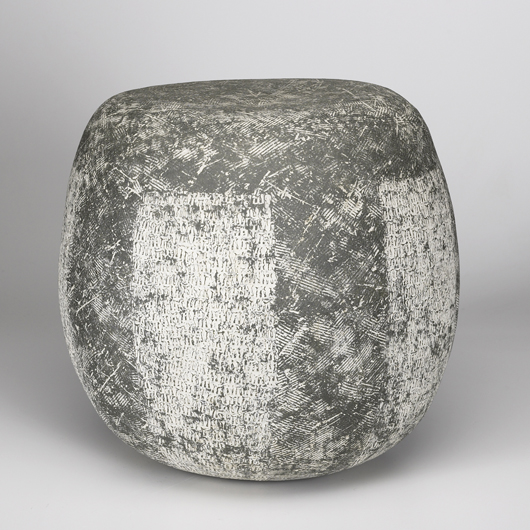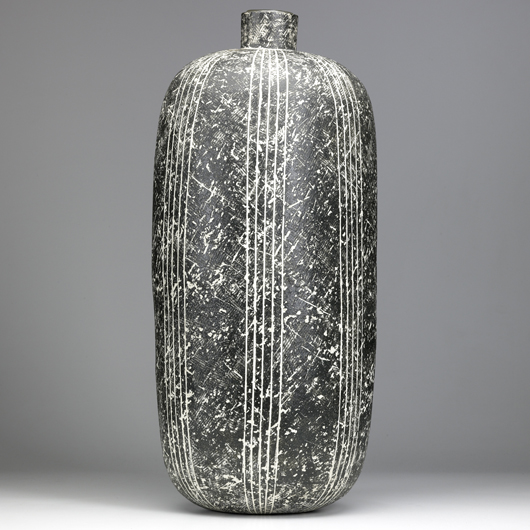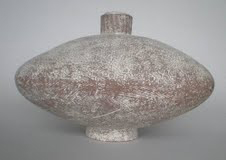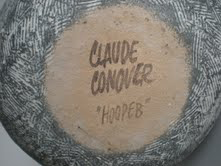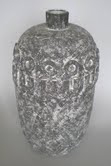Stoneware was principally prized for its durability in early American households. Fired at high temperatures until rock hard, the material was a natural choice for utilitarian jugs and storage jars.
In the 20th century, however, stoneware developed into an important artistic medium for studio potters. When shaped by the right hands, the strong material can have a dramatic impact on viewers. Collectors cherish the bold stoneware creations of artists as diverse as Peter Voulkos (1924-2002) and Toshiko Takaezu (b. 1922).
Less well-known but equally inventive, Claude Conover (1907-1994) turned to pottery in midlife, after a 30-year career as a commercial designer. Born in Pittsburgh, he received his training at the Cleveland Institute of Art and began working in that city. By the 1960s, he was devoting himself to stoneware production in his studio.
The majority of Conover’s works are variations on a single form – a vase or vessel with curved body and narrow neck. He did not throw these pieces on a wheel but constructed them from rolled clay slabs, patted and smoothed into place by hand.
The artist used subtly distressed finishes and glazes in a palette of earth tones – deep brown, desert beige and rock gray. The ceramics look almost like archaeological artifacts, uncovered in a mysterious excavation somewhere in South America or the Middle East.
Geometric designs are incised or impressed on the surface with blades and rollers. Some faint patterns resemble the remains of an unknown alphabet. Occasionally ornamentation cut in high relief projects from the side of a vessel.
Equally exotic are the fanciful individual titles he invented for each work, which are painted on the base near his signature. Sold in recent Rago auctions, the ovoid Naylac – divided into four panels – brought $10,370; Hayal – broadly flaring in the middle – $9,760; Toltec – covered with an incised grid – also $10,370.
David Rago of Lambertville, N.J., has sold more examples of Conover pottery in his sales that any other auction house. “What makes his work interesting to me is, although you’re dealing with similar components in almost all the pieces, there is such variety. They all have a different feel about them,” he said.
Because of Conover’s creative process, each vessel is unique in form, and the sensitive earth-tone decoration gives them an individual character. His stoneware examples currently sell in the $5,000-$15,000 range.
“The differences are subtle,” continued Rago. “People want a grouping of them, not just a single example.” Collectors are in luck for he added. “We have six or seven pieces coming up in October, including three from one consigner.”
“They’re pretty wonderful. One tall example looks like a big water tower – a cylindrical shaft and a bulbous top with that typical pinched small opening. All three of them have a two-tone glaze treatment – they’re pretty marvelous.”
Conover displayed his work in the annual juried May Shows at the Cleveland Museum of Art and at other exhibitions around the country. In 1983, he was the recipient of the prestigious Cleveland Arts Prize in Visual Arts. The same year Fred Griffith made a television documentary on the potter titled The Bottle Maker, rather a simple title for the complex constructions that emerged from Conover’s studio.
These facts and further personal and professional information are included in a brief biography prepared by Diane De Grazie in 2008 for the arts organization Web site www.clevelandartsprize.com.
Unlike many artists, Conover appears to have adhered to a disciplined schedule, so that he produced a consistent number of vases each week. Yet, as David Rago indicated above, the appeal of the artist’s work lies in the singularity of each piece. Regularity of method did not result in repetitive designs.
Cleveland dealer Rachel Davis offers Conover’s work in the Fine Arts auctions she holds in March and October. “He was very successful in his day. A number of the florist shops in town would carry his vases, back when he was actively working. I personally love them – I think they’re fabulous,” she said.
“The upcoming Fine Arts sale is on Oct. 23rd. We try to feature our Cleveland School artists. This fall, we have two Conover pieces in the sale. One is a vase, and the other piece is a garden seat.”
Conover also produced boulder-like garden seats with rounded edges, which measure around 16 inches by 16 inches. Davis has also offered a rare jardinière, sold in 2005 for $900.
Even more of a departure from his usual production was a limited group of animal figures. Rachel Davis said, “He would make the animals as gifts for friends and friends’ children. I see the cat most often, I have a bird in my personal collection, and I have seen a giraffe in someone’s home.”
Karla Klein Albertson began her journalism career with an eye on antiquities, after receiving her master of arts degree in Classical Archaeology from Bryn Mawr College. For the past 10 years, she has written the Antiques column for the Home and Design section of the Philadelphia Inquirer. She contributes regularly to Maine Antique Digest, Early American Life and other trade and collector publications. Decades of pop culture have made an impact as well, sparking an interest in rock music history, Silver Age comics, martial arts, movie memorabilia and surf/skate/snowboard culture.
ADDITIONAL LOTS OF NOTE
